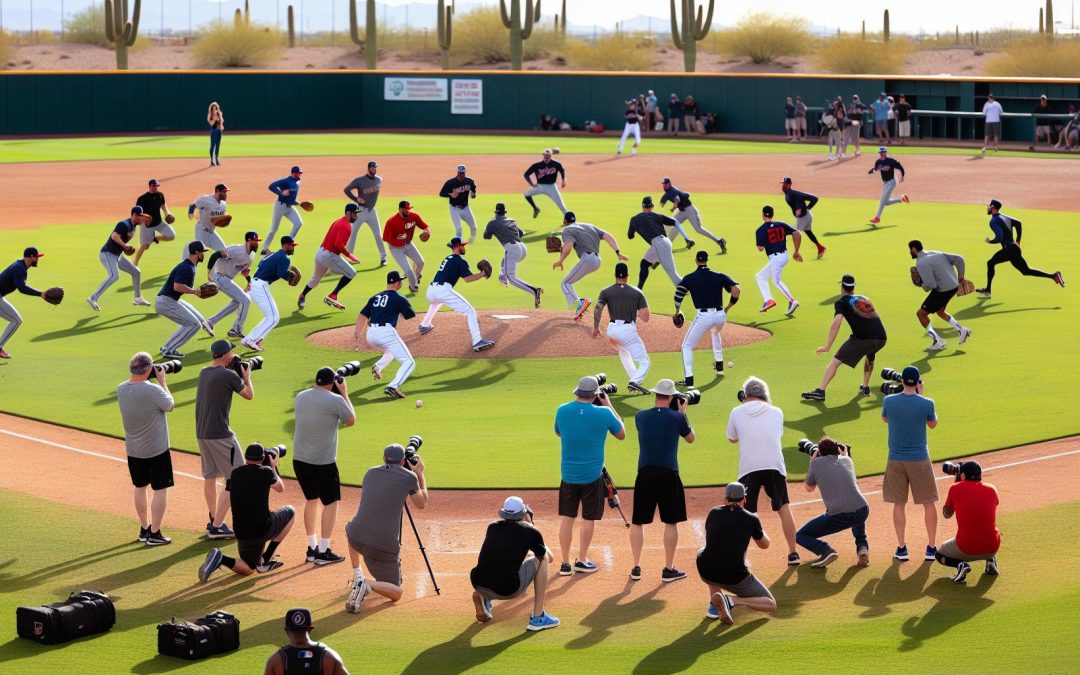Springtime in Scottsdale, Arizona, isn’t just about blooming cacti and warming temperatures; it’s a paradise for baseball fans and photographers alike. I’ve spent many a March day basking in the vibrant atmosphere of spring training, camera in hand, and let me tell you, the photo ops are as plentiful as they are stunning.
From the crack of the bat to the intimate settings of the ballparks, Scottsdale offers a backdrop unlike any other for capturing the essence of America’s pastime. Whether you’re a seasoned photographer or just snapping pics on your phone, the energy and excitement of spring training make for unforgettable shots. Let’s dive into some of the best spots and moments to capture during this exhilarating time of year.
Top Spring Training Locations in Scottsdale
When it comes to nabbing those once-in-a-lifetime shots of baseball’s finest or simply soaking up the ambiance of America’s favorite pastime amid the vibrant hues of spring, certain spots in Scottsdale stand out. Let me guide you through my personal picks for the top spring training locations that offer not only thrilling baseball action but also a picture-perfect backdrop for any photography enthusiast.
First on my list is Salt River Fields at Talking Stick. This spectacular venue is not only home to the Arizona Diamondbacks and Colorado Rockies for spring training, but it’s also a paradise for photographers. The unique architecture and the panoramic mountain views in the background provide an unmatched setting for capturing the essence of spring training in Arizona. Salt River Fields is bustling with activity, offering myriad photo ops from dugout candids to sprawling landscape shots that embody the spirit of spring baseball.
Another gem is Scottsdale Stadium, the winter home of the San Francisco Giants. Nestled in the heart of downtown Scottsdale, this stadium offers a quaint, more intimate setting for photos. The proximity to players here is unparalleled, allowing for detailed action shots and up-close portraits of your favorite athletes. The surrounding area, peppered with quirky shops and vibrant eateries, also serves as a fantastic canvas for more lifestyle-oriented photographs.
Here’s a snapshot of why these locations are my favorite:
- Unique backdrops: Mountain vistas at Salt River Fields and urban charm around Scottsdale Stadium.
- Access to players: Up-close photo opportunities, especially at Scottsdale Stadium.
- Diverse photo settings: From action shots on the field to lifestyle photos in the surrounding areas.
Exploring these spots, I’ve found that the dynamic nature of spring training sessions combined with the laid-back, festive atmosphere provides a wealth of material for photographers of all levels. Whether you’re after the high-energy moments of a game or the more serene, scenic aspects of Scottsdale’s landscape, these locations won’t disappoint.
Capturing the Action: On Field Photography Tips

When it comes to snapping the perfect action shot at spring training games, I’ve picked up a few tricks over the years that might just help you get that magazine-cover photo. First and foremost, timing is everything. You’ve got to keep your eyes peeled and your camera ready at all times because the best moments happen in the blink of an eye.
One thing I always remind myself is to pay attention to the light. Early morning and late afternoon games provide that magical golden hour light that every photographer dreams of. It not only illuminates the field in a warm glow but also accentuates the players, making your photos pop.
Let’s talk gear for a second. You don’t necessarily need the most expensive camera to capture great photos, but a good telephoto lens can make a world of difference. It allows you to get close-up shots of the players in action, even from the stands. A lens with a focal length of 200mm or more is ideal, but remember, it’s more about how you use the equipment than the equipment itself.
Shutter speed is your best friend when capturing fast-moving subjects. I typically set mine to at least 1/1000th of a second to freeze the action. This might mean increasing your ISO on cloudy days, but it’s a worthy trade-off to avoid blurry shots.
Lastly, anticipation is key. Learning the game and watching the players can give you clues about what’s going to happen next. Whether it’s a pitcher winding up for a fastball or a batter preparing to swing, anticipating these moments can help you capture dynamic and engaging photos.
Armed with these tips, you’re all set to capture the excitement of spring training in Scottsdale. Remember, the best shot is the one that tells a story, so focus on the emotion and energy of the game as much as the technical aspects.
Behind the Scenes: Players and Coaches Up Close
Walking around the sprawling complexes in Scottsdale, Arizona during spring training, I’ve always found myself drawn to the moments that aren’t splashed across the front page of the sports section. It’s in these quieter, off-the-field instances that you really capture the essence of baseball’s preseason.
For anyone aiming to bring a fresh perspective to their photo albums or social media feeds, focusing on the players and coaches in their more unguarded moments can be incredibly rewarding. I’m talking early mornings when the fields are just stirring awake, or the tail end of practice when the players are cooling down. These times offer a unique glimpse into the personalities and camaraderie that define a team.
One of my favorite strategies is to arrive early, before the crowds swell. This is when players are often the most accessible, engaging in warm-up exercises or simply enjoying a quiet moment before the day ramps up. You’ll find that a telephoto lens is invaluable here, allowing you to capture these candid shots without intruding on the subjects.
Here’s a quick tip: don’t overlook the coaches. They’re often the unsung heroes of spring training, and their interactions with players can provide some of the most compelling imagery. Whether it’s a manager offering some one-on-one advice or a pitching coach tweaking a player’s form, these moments are gold for any photographer.
Equipped with patience and the right gear, anyone can document the dynamic world of spring training. And while the action shots during games are fantastic, there’s something incredibly special about the more intimate, behind-the-scenes views that offer a deeper story of the players and coaches who bring the game to life.
The Best Times of Day for Optimal Lighting
When I’m out in Scottsdale capturing the essence of spring training, finding the perfect light is as crucial as the moment itself. Golden hour has never let me down. This magical time, right after sunrise or just before sunset, bathes the world in a soft, warm glow that makes every shot look like something out of a dream.
In the mornings, I prefer to arrive just as the sun peeks over the horizon. The early light is not only gentle on the subjects, bringing out the rich textures of the uniforms and the field, but it also adds a layer of emotion and serenity to the photos. Players often appear more focused and serene, providing a contrast to the intensity of the games.
| Time of Day | Lighting Quality | Recommended Subject |
|---|---|---|
| Early Morning | Soft, Warm | Players warming up, Quiet moments |
| Sunset | Rich, Golden | Action shots, Scenic backgrounds |
Evening offers a different charm. As the sun sets, the contrast increases, offering dramatic shadows and a richness of color that’s hard to capture at any other time. This lighting emphasizes the intensity and dynamics of the game, making it perfect for capturing those action-packed moments or the vibrant landscape of the stadium against the backdrop of the Scottsdale sky.
By utilizing natural light at these times, I can create compelling narratives without saying a word. The key is to watch how the light interacts with the scene and to be ready to capture that interaction. Whether it’s a quiet moment of reflection or the explosive energy of a play, the right lighting can turn a good photo into an unforgettable one.
Editing and Sharing Your Spring Training Photos

Once I’ve captured the serene mornings and dynamic evenings of spring training in Scottsdale, the next step is bringing those images to life through editing. It’s an exciting process where the raw material of my experience meets creativity. First off, I ensure that the colors reflect the true warmth of the Arizona sun or the coolness of the shadows. Adjusting the contrast and brightness helps to make the players and the action pop.
I’ve found that a slight saturation boost can emphasize the rich blues of the sky or the greens of the field without making the image look unnatural. For those early morning shots, adjusting the white balance can help recapture the golden hue that might be lost in the camera’s default settings.
When it comes to sharing these moments, I aim for platforms that appreciate high-quality imagery. Instagram is a favorite because it’s visually oriented, and hashtags like #SpringTraining, #Scottsdale, and #BaseballPhotography can help attract fellow enthusiasts. I don’t shy away from sharing before-and-after edits in my stories; it’s a great way to engage with my audience and share some behind-the-scenes of the editing process.
For more professional networking, I turn to platforms like Flickr or 500px. These communities not only appreciate the finer details of a well-composed photo but also provide a space for constructive feedback, which is invaluable for honing my skills.
Regardless of the platform, the key is consistent posting. By scheduling posts during high engagement times, I ensure my spring training stories reach as many eyes as possible. It’s not just about showcasing my work; it’s about sharing the beauty of baseball during a time of year that brings players and fans together in anticipation.
Conclusion
So there you have it! Capturing the essence of spring training in Scottsdale has been an incredible journey for me. It’s all about finding that perfect balance in your photos and then sharing them with a community that gets just as excited about the details as you do. Whether it’s tweaking the white balance to get those morning shots just right or engaging with fellow photography enthusiasts on social media, every step is a chance to refine your craft and connect with others. Remember, it’s not just about the photos you take but also the stories you tell and the connections you make. Happy shooting!







